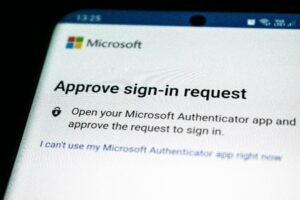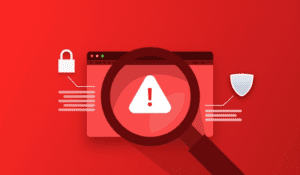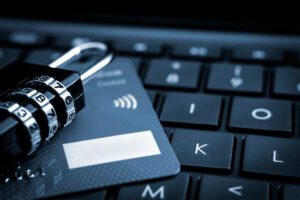What is Business Identity Theft?
Identity theft, a term that often conjures images of stolen Social Security numbers and compromised credit cards, extends its reach beyond individuals, infiltrating the very core of businesses. As commerce thrives in virtual spaces, criminals are finding increasingly sophisticated ways to exploit vulnerabilities. According to Federal Trade Commission (FTC) data, consumers and organizations lost $5.8 billion in 2021 due to identity theft – a shocking 70% increase compared to the previous year. The FTC has even proposed a new rule to combat government and business impersonation scams.
Business identity theft is a malicious scheme that involves impersonating owners, officers, or employees to conduct illegal activities, establish lines of credit, and steal sensitive company information. This type of identity theft presents a significantly riskier landscape compared to personal identity theft. Companies have higher credit limits, maintain substantial financial reserves, and engage in larger transactions, providing the opportunity for fraudulent activities to blend in with legitimate ones. Moreover, their established brand names and reputations can be exploited to deceive both fellow businesses and individual consumers, enticing them into sharing sensitive personal and financial details, including credit card numbers.
As the threat of business identity theft looms, its potential aftermath is marred by accumulating debt, tarnished credit profiles, and shattered reputations. Alarming reports from the National Cybersecurity Society (NCSS) serve as stark reminders of how increasingly common this trend has become. Depending on the industry, businesses may even have specific compliance requirements to protect sensitive information against these attacks.
This article will dive deeper into identity theft, shedding light on its multifaceted nature and offering key strategies and actionable steps to strengthen your organization’s cybersecurity and protect your business identity from predators.
How Does Business Identity Theft Happen?
Business identity theft casts its shadow over organizations of all sizes and manifests through various methods that criminals use to exploit vulnerabilities in the digital realm. So, how does identity theft happen?
Impersonation and Exploitation
Criminals often begin by assuming the identities of key figures within a company. This could range from impersonating owners and executives to assuming the roles of trusted employees to gain access to sensitive information, financial resources, and even establish lines of credit in the company’s name.
Website Manipulation and Data Breaches
Another avenue employed by identity thieves involves manipulating a company’s digital presence. This can include redirecting website traffic to malicious sites designed to harvest customer data. In more advanced schemes, criminals may infiltrate databases to steal critical business information, putting both the company and its clientele at risk.
Trademark Hijacking and Ransom Demands
Criminals may also target a company’s intellectual property, such as logos or brand names. They might unlawfully register these assets as their own, holding them hostage for hefty ransoms. This tactic not only threatens a company’s identity but also its financial stability.
Exploiting Trusted Relationships
Established companies have a network of partnerships and clients who rely on their integrity. Identity thieves exploit these relationships, posing as trusted entities to gain access to sensitive data or divert financial resources.
Leveraging Reputational Capital
A company’s reputation is one of its most valuable assets. Identity thieves recognize this and may use it to their advantage. By posing as a reputable entity, they can deceive other businesses and individuals into disclosing confidential information or entering into fraudulent transactions.
Camouflaging Among Legitimate Transactions
With companies conducting a myriad of transactions on a daily basis, fraudulent activities can sometimes camouflage themselves amidst the legitimate ones. This makes it challenging to detect unauthorized access or manipulative actions until it’s too late.
Understanding how identity theft can occur is the first step in crafting a robust defense strategy for the issue.
The Consequences of Business Identity Theft
Windows business device threats increased by 143% in 2021. Identity theft within a business context can have far-reaching and devastating consequences, impacting various facets of the organization:
- Financial Strain and Losses: One of the most immediate and tangible consequences of identity theft is financial strain. Stolen funds, fraudulent transactions, and unauthorized access to company accounts can lead to significant monetary losses. These financial setbacks can impede operational capabilities, hinder growth, and even jeopardize the long-term success of the business.
- Legal Ramifications: Identity theft can lead to complex legal entanglements and related legal fees. Businesses may find themselves in legal battles to reclaim stolen assets, dispute fraudulent transactions, or rectify damages caused by the breach.
- Reputational Damage: The trust of customers, clients, and partners is invaluable in the business world. When a company falls victim to identity theft, it not only risks financial losses but also endangers its reputation. The breach of trust can have a long-lasting impact, potentially leading to customer attrition, negative reviews, and a tarnished brand image.
- Operational Disruption: Identity theft often necessitates a significant amount of time and resources to resolve. This can divert attention away from core business operations, leading to delays, missed opportunities, and decreased productivity. In some cases, businesses may even face temporary shutdowns or disruptions in service.
- Regulatory Non-Compliance: Many industries have strict regulatory frameworks in place to protect sensitive information. Falling victim to identity theft can result in non-compliance with these regulations, potentially leading to fines, penalties, and additional legal complications.
- Loss of Intellectual Property: For businesses that rely on proprietary technologies or intellectual property, identity theft can result in the unauthorized access, theft, or dissemination of these critical assets. This can lead to lost competitive advantages and potential legal battles over intellectual property rights.
- Emotional Toll on Employees: The aftermath of an identity theft incident can take an emotional toll on employees. Fear, anxiety, and stress can permeate the workplace, potentially affecting morale, productivity, and overall employee well-being.
- Customer and Partner Relations: Rebuilding trust with customers, clients, and partners after an identity theft incident can be an arduous process. It may require additional investments in communication, transparency, and enhanced security measures to reassure stakeholders.
Moving beyond the immediate consequences of identity theft, it’s critical for businesses to take proactive measures to protect their operations. One critical aspect of this defense strategy involves adhering to compliance regulations.
Business Identity Theft and Industry-Specific Compliance
When it comes to cybersecurity, a one-size-fits-all approach won’t suffice. Different industries face distinct compliance requirements, necessitating tailored strategies to improve their defenses against the ever-evolving threat of business identity theft.
Industries handling sensitive information, such as healthcare or finance, bear a heavier burden when safeguarding against identity theft. Regulatory bodies impose stringent guidelines to ensure the confidentiality and integrity of data. For instance, in the healthcare sector, the Health Insurance Portability and Accountability Act (HIPAA) mandates robust safeguards for patient information, including stringent access controls and encryption protocols. Any business that deals with online payments is subject to adhering to the Payment Card Industry Data Security Standard (PCI DSS).
Similarly, financial institutions must adhere to the rigorous standards set forth by the Gramm-Leach-Bliley Act (GLBA) to protect their clients’ financial data. This includes implementing multifaceted authentication processes and maintaining comprehensive audit trails.
Example: Secure Bank Account Connections
The financial sector’s approach to securing bank account connections is a concrete illustration of industry-specific compliance. When establishing direct transfers between external bank accounts, stringent measures are implemented to verify the accounts’ legitimacy. This often involves the initiation of small deposits as a means of confirming the accuracy of the linked account.
However, it’s critical to recognize that even seemingly robust verification methods can be vulnerable if relied upon in isolation. A layered approach to authentication is crucial in mitigating the risks associated with business identity theft.

Mitigating Business Identity Theft
Tip 1: Diversified Verification Methods
Adopting a multifaceted authentication approach is imperative to security. Let’s explore the various verification methods and their unique strengths and considerations.
Biometrics: Fingerprint and Facial Recognition
To grant access, biometric authentication leverages distinct physical attributes, such as fingerprints or facial features. While offering highly individualized identifiers for each user, it’s crucial to acknowledge the potential for replication.
Note: Technological advancements have made replicating physical identifiers like fingerprints more attainable for determined threat actors in recent years. So, while biometrics add a strong layer of security, they should be paired with additional authentication measures.
Text Verification: Generating Unique Codes
Text verification involves sending a unique code to a user’s mobile device upon login. While this method provides an extra layer of security, it’s not without vulnerabilities.
Note on Intercept Risks (e.g., SIM swapping): Determined attackers may attempt to intercept these codes, a technique known as SIM swapping. This underscores the importance of combining text verification with other authentication methods.
Tip 2: Combined Authentication
While individual authentication methods offer valuable layers of security, the true strength lies in their collective synergy.
By integrating diverse authentication techniques, businesses create a barrier that significantly mitigates the risk of unauthorized access. For example, combining biometrics, text verification, and passwords creates a multi-layered defense that requires attackers to breach multiple barriers, each with its unique challenges.
This layered approach is like a complex lock with multiple intricate mechanisms. Each one must be navigated successfully for access to be granted. This deters potential attackers and buys precious time for businesses to detect and respond to any suspicious activity.
The combination of authentication methods acts as a safeguard, ensuring that only authorized personnel gain access to sensitive business information. It provides a critical line of defense and prevents unauthorized transactions, data breaches, and other malicious activities that can have devastating consequences.
By adopting a holistic approach to authentication, businesses can bolster their defenses against identity theft, safeguarding their most valuable assets: their data and reputation.
Tip 3: Create Strong Passwords
A well-constructed password serves as a strong barrier against unauthorized access. However, users often fall prey to common pitfalls, such as choosing easily guessable passwords or reusing them across multiple platforms.
Creating strong passwords is a critical defense against identity theft. Robust passwords, characterized by a combination of upper and lower-case letters, numbers, and special characters, form a strong barrier against unauthorized access. Each account should have its unique password to prevent compromising multiple accounts with a single breach. This practice is especially crucial for safeguarding sensitive financial information, like bank accounts and credit cards, and protecting personal data from falling into the wrong hands.
If managing passwords is too difficult on your own, consider investing in a password manager, like 1Password, to create, store, and manage your passwords and accounts.
Tip 4: Implement Proactive Measures
Beyond authentication methods and strong passwords, businesses can implement additional proactive measures to enhance their overall security posture.
Regular Commercial Credit Report Monitoring
Keeping a vigilant eye on your business’s commercial credit report can be instrumental in detecting any suspicious activity early on. Unusual transactions or unauthorized changes can serve as red flags, allowing for prompt intervention.
Cybersecurity Education for Staff
Your team is often the first line of defense against cyber threats. Educating staff about best practices, recognizing phishing attempts, and fostering a culture of security awareness can strengthen your business’s resilience.
Invest in Cybersecurity Insurance
While robust security measures can significantly reduce the risk of identity theft, having a safety net in the form of cybersecurity insurance provides an added layer of protection. It offers financial support in case of a breach, helping mitigate potential damages.
Tip 5: Ensure Compliance with Privacy and Security Regulations
As mentioned earlier, compliance with privacy and security regulations is non-negotiable. It’s a legal obligation that safeguards sensitive data, establishes trust, and mitigates reputational risks. Additionally, it fosters a culture of security awareness, enhancing overall resilience. Keeping up with evolving regulations is key to effective risk management.
Tip 6: Establish a Robust Incident Response Plan
In the event of business identity theft, an incident response plan provides a structured and well-defined set of actions to take. It outlines specific procedures for swiftly detecting and containing the breach. This is vital in minimizing the extent of unauthorized access and preventing further damage. The plan also guides the preservation of digital evidence. This evidence is essential for conducting a thorough investigation into the incident, identifying the methods used by the cybercriminals, and potentially even tracing them. It serves as the foundation for any legal action that may be taken against the perpetrators.
Communication is another critical aspect. The plan establishes clear channels and protocols for notifying all relevant stakeholders, including employees, customers, and authorities. This timely and transparent communication helps manage the fallout from the incident and maintain trust with those affected. It also provides a roadmap for recovery and remediation. It outlines the steps to restore compromised systems, update security measures, and implement additional safeguards to prevent future incidents.
Finally, an incident response plan facilitates continuous improvement. It allows businesses to learn from the incident, identify areas for enhancement in their security infrastructure, and implement necessary changes. This iterative process strengthens the overall resilience of the organization against future identity theft attempts.
An incident response plan is not only a best practice but also a critical defense mechanism against the repercussions of identity theft. It provides a structured approach to effectively respond to breaches, minimizing damage and facilitating a smoother recovery process.
The Collective Effort of Cybersecurity
Remember, safeguarding against business identity theft is a collective effort. It necessitates vigilance, education, and proactive measures. By implementing these strategies, you’re taking a proactive step toward securing your business.
If you’re ready to strengthen your business against identity theft, contact us today to learn how Edge’s cybersecurity experts can work with you to implement customized verification methods tailored to your business’s unique needs.






